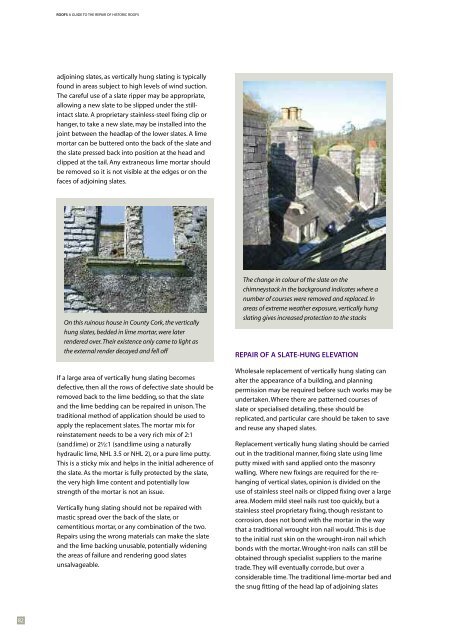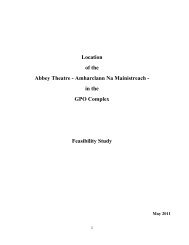A Guide to the Repair of Historic Roofs - Dublin City Council
A Guide to the Repair of Historic Roofs - Dublin City Council
A Guide to the Repair of Historic Roofs - Dublin City Council
Create successful ePaper yourself
Turn your PDF publications into a flip-book with our unique Google optimized e-Paper software.
ROOFS A GUIDE TO THE REPAIR OF HISTORIC ROOFSadjoining slates, as vertically hung slating is typicallyfound in areas subject <strong>to</strong> high levels <strong>of</strong> wind suction.The careful use <strong>of</strong> a slate ripper may be appropriate,allowing a new slate <strong>to</strong> be slipped under <strong>the</strong> stillintactslate. A proprietary stainless-steel fixing clip orhanger, <strong>to</strong> take a new slate, may be installed in<strong>to</strong> <strong>the</strong>joint between <strong>the</strong> headlap <strong>of</strong> <strong>the</strong> lower slates. A limemortar can be buttered on<strong>to</strong> <strong>the</strong> back <strong>of</strong> <strong>the</strong> slate and<strong>the</strong> slate pressed back in<strong>to</strong> position at <strong>the</strong> head andclipped at <strong>the</strong> tail. Any extraneous lime mortar shouldbe removed so it is not visible at <strong>the</strong> edges or on <strong>the</strong>faces <strong>of</strong> adjoining slates.On this ruinous house in County Cork, <strong>the</strong> verticallyhung slates, bedded in lime mortar, were laterrendered over. Their existence only came <strong>to</strong> light as<strong>the</strong> external render decayed and fell <strong>of</strong>fIf a large area <strong>of</strong> vertically hung slating becomesdefective, <strong>the</strong>n all <strong>the</strong> rows <strong>of</strong> defective slate should beremoved back <strong>to</strong> <strong>the</strong> lime bedding, so that <strong>the</strong> slateand <strong>the</strong> lime bedding can be repaired in unison. Thetraditional method <strong>of</strong> application should be used <strong>to</strong>apply <strong>the</strong> replacement slates. The mortar mix forreinstatement needs <strong>to</strong> be a very rich mix <strong>of</strong> 2:1(sand:lime) or 2½:1 (sand:lime using a naturallyhydraulic lime, NHL 3.5 or NHL 2), or a pure lime putty.This is a sticky mix and helps in <strong>the</strong> initial adherence <strong>of</strong><strong>the</strong> slate. As <strong>the</strong> mortar is fully protected by <strong>the</strong> slate,<strong>the</strong> very high lime content and potentially lowstrength <strong>of</strong> <strong>the</strong> mortar is not an issue.Vertically hung slating should not be repaired withmastic spread over <strong>the</strong> back <strong>of</strong> <strong>the</strong> slate, orcementitious mortar, or any combination <strong>of</strong> <strong>the</strong> two.<strong>Repair</strong>s using <strong>the</strong> wrong materials can make <strong>the</strong> slateand <strong>the</strong> lime backing unusable, potentially widening<strong>the</strong> areas <strong>of</strong> failure and rendering good slatesunsalvageable.The change in colour <strong>of</strong> <strong>the</strong> slate on <strong>the</strong>chimneystack in <strong>the</strong> background indicates where anumber <strong>of</strong> courses were removed and replaced. Inareas <strong>of</strong> extreme wea<strong>the</strong>r exposure, vertically hungslating gives increased protection <strong>to</strong> <strong>the</strong> stacksREPAIR OF A SLATE-HUNG ELEVATIONWholesale replacement <strong>of</strong> vertically hung slating canalter <strong>the</strong> appearance <strong>of</strong> a building, and planningpermission may be required before such works may beundertaken. Where <strong>the</strong>re are patterned courses <strong>of</strong>slate or specialised detailing, <strong>the</strong>se should bereplicated, and particular care should be taken <strong>to</strong> saveand reuse any shaped slates.Replacement vertically hung slating should be carriedout in <strong>the</strong> traditional manner, fixing slate using limeputty mixed with sand applied on<strong>to</strong> <strong>the</strong> masonrywalling. Where new fixings are required for <strong>the</strong> rehanging<strong>of</strong> vertical slates, opinion is divided on <strong>the</strong>use <strong>of</strong> stainless steel nails or clipped fixing over a largearea. Modern mild steel nails rust <strong>to</strong>o quickly, but astainless steel proprietary fixing, though resistant <strong>to</strong>corrosion, does not bond with <strong>the</strong> mortar in <strong>the</strong> waythat a traditional wrought iron nail would. This is due<strong>to</strong> <strong>the</strong> initial rust skin on <strong>the</strong> wrought-iron nail whichbonds with <strong>the</strong> mortar. Wrought-iron nails can still beobtained through specialist suppliers <strong>to</strong> <strong>the</strong> marinetrade. They will eventually corrode, but over aconsiderable time. The traditional lime-mortar bed and<strong>the</strong> snug fitting <strong>of</strong> <strong>the</strong> head lap <strong>of</strong> adjoining slates82
















